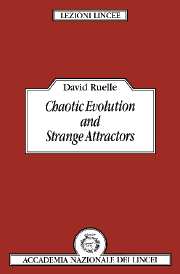Book contents
- Frontmatter
- Contents
- Foreword
- Introduction
- Part I Steps to a deterministic interpretation of chaotic signals
- Part II The ergodic theory of chaos
- 7 Invariant probability measures
- 8 Physical measures
- 9 Characteristic exponents
- 10 Invariant manifolds
- 11 Axiom A and structural stability
- 12 Entropy
- 13 Dimensions
- 14 Resonances
- 15 Conclusions
- References
- Bibliography
- Index
- Frontmatter
- Contents
- Foreword
- Introduction
- Part I Steps to a deterministic interpretation of chaotic signals
- Part II The ergodic theory of chaos
- 7 Invariant probability measures
- 8 Physical measures
- 9 Characteristic exponents
- 10 Invariant manifolds
- 11 Axiom A and structural stability
- 12 Entropy
- 13 Dimensions
- 14 Resonances
- 15 Conclusions
- References
- Bibliography
- Index
Summary
In general, it is exceptional that an attractor carries only one ergodic invariant measure ρ. In typical cases there are uncountably many distinct ergodic measures. Nevertheless, as we have already mentioned in part I, in physical experiment and in computer simulations it seems that one invariant probability measure ρ is
produced more or less automatically by the time that the system spends in various part of the space M. Thus, there is a selection process of the so-called physical measure ρ.
The advantage of the ergodic approach lies in the fact that there are important theorems which apply to all ergodic measures, and we do not have to worry immediately about which ergodic measure is physical. (Furthermore, as noted earlier, there are always some ergodic measures on a compact invariant set.)
In some cases, we can attempt to construct some selection processes to obtain measures which describe physical time averages. We have seen in chapter 6 that a candidate for this purpose is the Kolmogorov measure, obtained by the ‘zero-noise’ limit ε → 0 of a stationary probability measure ρε. Another possibility is represented by a so-called SRB measure, which is the measure given by the time average (43) for all x0 in a set A ⊂ M with Lebesgue measure m(A) > 0. Moreover we shall see that for Axiom-A systems these two measures coincide.
However, many important results of ergodic theory hold for an arbitrary invariant measure ρ. This is the case, for example, of the existence of characteristic exponents.
- Type
- Chapter
- Information
- Publisher: Cambridge University PressPrint publication year: 1989

